OR/15/033 Geological summary: Difference between revisions
No edit summary |
|||
| (4 intermediate revisions by the same user not shown) | |||
| Line 3: | Line 3: | ||
==Previous work== | ==Previous work== | ||
The tungsten veins at the mine are associated with a cupola of the Skiddaw Granite. The granite here was emplaced into folded Skiddaw Slates, comprising mudstones and greywackes of Ordovician age. These rocks had already been intruded by the gabbro and granophyre of the Carrock Fell Complex, intrusion of which caused extensive contact metamorphism of the slates to hornfels (Cooper et al; 2004). | The tungsten veins at the mine are associated with a cupola of the Skiddaw Granite. The granite here was emplaced into folded Skiddaw Slates, comprising mudstones and greywackes of Ordovician age. These rocks had already been intruded by the gabbro and granophyre of the Carrock Fell Complex, intrusion of which caused extensive contact metamorphism of the slates to hornfels (Cooper et al; 2004<ref name="Cooper 2004">COOPER, A H, FORTEY, NJ, HUGHES, R A, MOLYNEUX, S G, MOORE, R M, RUSHTON, A W A and STONE, P. 2004. The Skiddaw Group of the English Lake District: memoir for parts of sheets 22 Maryport, 23 Cockermouth, 24 Penrith, 28 Whitehaven, 29 Keswick, 30 Appleby, 31 Brough and 48 Ulverston; Memoir of the British Geological Survey; 147p. </ref>). | ||
Shepherd et al (1976) suggest that the tungsten mineralisation is associated with late stage cooling of the granite. Fluid inclusion studies of the mineralisation suggests that the tungsten mineralisation was deposited at temperatures between about 350⁰C and 170⁰ while the later ‘lead’ veins were deposited at temperatures of less than 150⁰C (Ball et al; 1985). | Shepherd et al (1976)<ref name="Shepherd">SHEPHERD, T J, BECKINSALE, R D, RUNDLE, C C, DURHAM, J J. 1976. Genesis of Carrock Fell tungsten deposit, Cumbria: fluid inclusion and isotopic study, ''Transactions of the Institution of Mining and Metallurgy Section B: Applied Earth Sciences'' 85(1) 1976 p.B63–B73. </ref> suggest that the tungsten mineralisation is associated with late stage cooling of the granite. Fluid inclusion studies of the mineralisation suggests that the tungsten mineralisation was deposited at temperatures between about 350⁰C and 170⁰ while the later ‘lead’ veins were deposited at temperatures of less than 150⁰C (Ball et al; 1985<ref name="Ball">BALL, T K, FORTEY, N J, and SHEPHERD, T J. 1985. Mineralisation at the Carrock Fell Tungsten Mine, N England: Paragenetic, fluid inclusion and geochemical study; ''Mineralium Deposita'' 20, pp 57–65. </ref>). | ||
==New underground geological mapping == | ==New underground geological mapping == | ||
Because the majority of the workings have previously been geologically mapped (Moore; 1977) the aim of the work reported here was to map those parts of the mine that were developed at a late stage in the working of the deposit which have not previously been geologically mapped. Only the last phase of workings was examined in detail. These were the workings on Smith’s Vein North, Smith’s Vein South and Smith’s Vein East. As noted above the host rocks consist of Skiddaw Granite, which is usually intensely greisenised adjacent to the tungsten veins, emplaced into Skiddaw Slate which had previously been contact metamorphosed to hornfels by the intrusion of the Carrock Fell Complex Gabbro. This mapping completed the basic geological mapping of the accessible mine workings and is presented in Figure 3 which also includes the previous work by Moore (1977). | Because the majority of the workings have previously been geologically mapped (Moore; 1977<ref name="Moore">MOORE, J McM. 1977. Carrock Fell Tungsten Mine, Cumbria; Royal School of Mines Journal 1977; pp 7–14. </ref>) the aim of the work reported here was to map those parts of the mine that were developed at a late stage in the working of the deposit which have not previously been geologically mapped. Only the last phase of workings was examined in detail. These were the workings on Smith’s Vein North, Smith’s Vein South and Smith’s Vein East. As noted above the host rocks consist of Skiddaw Granite, which is usually intensely greisenised adjacent to the tungsten veins, emplaced into Skiddaw Slate which had previously been contact metamorphosed to hornfels by the intrusion of the Carrock Fell Complex Gabbro. This mapping completed the basic geological mapping of the accessible mine workings and is presented in Figure 3 which also includes the previous work by Moore (1977)<ref name="Moore"></ref>. | ||
Where seen in the workings, the contact between the granite and the hornfels is intrusive with an irregular surface and frequent xenotiths of hornfels occur within the granite close to the contact. In places slickensides are present at the contact, suggesting post-emplacement minor faulting. | Where seen in the workings, the contact between the granite and the hornfels is intrusive with an irregular surface and frequent xenotiths of hornfels occur within the granite close to the contact. In places slickensides are present at the contact, suggesting post-emplacement minor faulting. | ||
| Line 17: | Line 17: | ||
When hosted in the hornfelsed slate the veins tend to reduce rapidly in size away from the granite and become somewhat less well defined and of variable width while the lack of stoping suggests that they have low tungsten values comprising mainly of vein quartz with minor wolframite and arsenopyrite. | When hosted in the hornfelsed slate the veins tend to reduce rapidly in size away from the granite and become somewhat less well defined and of variable width while the lack of stoping suggests that they have low tungsten values comprising mainly of vein quartz with minor wolframite and arsenopyrite. | ||
[[Image: | [[Image:OR15033_fig3.jpg|thumb|center|300px|'''Figure 3''' Simplified geological map of Carrock Mine (Survey based on a copy of a Carrock Fell Mining Company plan dated 1982 held by CATMHS; geology based on Moore; 1977<ref name="Moore 1977">MOORE, J McM. 1977. Carrock Fell Tungsten Mine, Cumbria; Royal School of Mines Journal 1977; pp 7–14. </ref> and new field work by the author).]] | ||
[[Image: | [[Image:OR15033_fig4.jpg|thumb|center|300px|'''Figure 4''' Contact of greisenised granite and hornfelsed Skiddaw Slate, Harding Vein North workings.]] | ||
In the gabbro the veins are less well defined, largely consisting of zones, up to ca 3m wide, of extensive quartz veining (Figure 5, Figure 6 and Figure 7]) that includes individual quartz veins (up to 30 cm wide) in an en-echelon arrangement, as one structure fades an adjacent one expands. Varying quantities of quartz, calcite (Figure 9), wolframite (Figure 8) and scheelite (Figure 9) occur with minor fluorite, arsenopyrite, pyrite, pyrrhotite, sphalerite, apatite, dolomite, ankerite, galena, molybdenite, bismuth, bismuthite, columbite, cuprodamite, malachite, chalcopyrite, wurtzite, chrysocolla and gypsum. The gypsum is the product of the weathering of the sulphide minerals and the reaction of the resulting sulphuric acid with the carbonate minerals present in the veins. The distribution of stoping shows that ore grade tungsten mineralisation is variable with zones of higher grade, workable ore interspersed with barren stretches of the vein structures. The veins are complex structures of multiple, quartz dominated, veins with cross cutting relationships demonstrating multiple phases of mineralisation. The larger veins in these structures usually being a late or the last phase of the tungsten mineralisation. All these veins have visible scheelite and wolframite. Large vugs, mainly lined with quartz crystals, are frequent in the larger vein structures. The carbonate mineralisation in the tungsten vein structures appears to be a late phase of this episode of mineralisation and is much more abundant in and close to the gabbro than elsewhere in the mine workings, suggesting that the gabbro was a likely source of the calcium. | In the gabbro the veins are less well defined, largely consisting of zones, up to ca 3m wide, of extensive quartz veining (Figure 5, Figure 6 and Figure 7]) that includes individual quartz veins (up to 30 cm wide) in an en-echelon arrangement, as one structure fades an adjacent one expands. Varying quantities of quartz, calcite (Figure 9), wolframite (Figure 8) and scheelite (Figure 9) occur with minor fluorite, arsenopyrite, pyrite, pyrrhotite, sphalerite, apatite, dolomite, ankerite, galena, molybdenite, bismuth, bismuthite, columbite, cuprodamite, malachite, chalcopyrite, wurtzite, chrysocolla and gypsum. The gypsum is the product of the weathering of the sulphide minerals and the reaction of the resulting sulphuric acid with the carbonate minerals present in the veins. The distribution of stoping shows that ore grade tungsten mineralisation is variable with zones of higher grade, workable ore interspersed with barren stretches of the vein structures. The veins are complex structures of multiple, quartz dominated, veins with cross cutting relationships demonstrating multiple phases of mineralisation. The larger veins in these structures usually being a late or the last phase of the tungsten mineralisation. All these veins have visible scheelite and wolframite. Large vugs, mainly lined with quartz crystals, are frequent in the larger vein structures. The carbonate mineralisation in the tungsten vein structures appears to be a late phase of this episode of mineralisation and is much more abundant in and close to the gabbro than elsewhere in the mine workings, suggesting that the gabbro was a likely source of the calcium. | ||
[[Image: | [[Image:OR15033_fig5.jpg|thumb|center|300px|'''Figure 5''' Harding Vein in forefield, Harding Vein North workings.]] | ||
[[Image: | [[Image:OR15033_fig6.jpg|thumb|center|300px|'''Figure 6''' One of the branches of Smith Vein, forefield.]] | ||
[[Image: | [[Image:OR15033_fig7.jpg|thumb|center|300px|'''Figure 7''' Smith No 3 level wolfram vein.]] | ||
[[Image: | [[Image:OR15033_fig8.jpg|thumb|center|300px|'''Figure 8''' Wolframite (bladed black crystals) in Harding Vein North.]] | ||
[[Image:OR15033_fig9.jpg|thumb|center|300px|'''Figure 9''' Smith Vein showing scheelite (brown) and calcite (pink).]] | |||
===Lead Veins=== | ===Lead Veins=== | ||
The tungsten bearing veins are cut by a number of later so called lead veins (Figure 10, Figure 11, Figure 12, Figure 13 and Figure 14). They were referred to by the miners as lead veins because they are genetically related to the veins further north in the Caldbeck Fells that have been extensively worked for lead ores (Cooper and Stanley; 1990). These trend approximately east-west and comprise multiphase crustiform banded mineralisation consisting of varying proportions of baryte and calcite with minor galena, sphalerite and other sulphides. The veins are near vertical, up to 1.5 m wide and can be traced between tungsten veins and between levels in the mine. The amount of lead in these veins was clearly not considered worth working and the veins have not been exploited anywhere in the mine workings. The veins show evidence of multiple phases of mineralisation and several phases of brecciation. The breccia show in Figure 12 is suggestive of collapse of broken wall rock into a fracture cavity prior to or at an early stage of mineralisation. | The tungsten bearing veins are cut by a number of later so called lead veins (Figure 10, Figure 11, Figure 12, Figure 13 and Figure 14). They were referred to by the miners as lead veins because they are genetically related to the veins further north in the Caldbeck Fells that have been extensively worked for lead ores (Cooper and Stanley; 1990<ref name="Cooper 1990">COOPER, M P and STANLEY, C J. 1990. Minerals of the English Lake District. Caldbeck Fells; London: Natural History Museum; 160p. </ref>). These trend approximately east-west and comprise multiphase crustiform banded mineralisation consisting of varying proportions of baryte and calcite with minor galena, sphalerite and other sulphides. The veins are near vertical, up to 1.5 m wide and can be traced between tungsten veins and between levels in the mine. The amount of lead in these veins was clearly not considered worth working and the veins have not been exploited anywhere in the mine workings. The veins show evidence of multiple phases of mineralisation and several phases of brecciation. The breccia show in Figure 12 is suggestive of collapse of broken wall rock into a fracture cavity prior to or at an early stage of mineralisation. | ||
[[Image:OR15033_fig10.jpg|thumb|center|300px|'''Figure 10''' Lead vein, east wall of Harding Vein North workings.]] | |||
[[Image: | [[Image:OR15033_fig11.jpg|thumb|center|300px|'''Figure 11''' Lead vein, west wall of Harding Vein North workings. Note multiple veins with blocks of wall rocks between.]] | ||
[[Image: | [[Image:OR15033_fig12.jpg|thumb|center|300px|'''Figure 12''' Smith No 3 level 2nd lead vein.]] | ||
[[Image: | [[Image:OR15033_fig13.jpg|thumb|center|300px|'''Figure 13''' Smith No 3 level 2nd lead vein.]] | ||
[[Image: | [[Image:OR15033_fig14.jpg|thumb|center|300px|'''Figure 14''' Lead vein cutting Harding Vein in roof of Harding Vein North workings.]] | ||
==References== | |||
[[category:OR/15/033 The Underground Geology of part of the Carrock Tungsten Mine, Caldbeck Fells | 03]] | [[category:OR/15/033 The Underground Geology of part of the Carrock Tungsten Mine, Caldbeck Fells | 03]] | ||
Latest revision as of 14:18, 28 July 2015
| Shaw, R P. 2015. The Underground Geology of part of the Carrock Tungsten Mine, Caldbeck Fells. British Geological Survey Internal Report, OR/15/033. |
Previous work
The tungsten veins at the mine are associated with a cupola of the Skiddaw Granite. The granite here was emplaced into folded Skiddaw Slates, comprising mudstones and greywackes of Ordovician age. These rocks had already been intruded by the gabbro and granophyre of the Carrock Fell Complex, intrusion of which caused extensive contact metamorphism of the slates to hornfels (Cooper et al; 2004[1]).
Shepherd et al (1976)[2] suggest that the tungsten mineralisation is associated with late stage cooling of the granite. Fluid inclusion studies of the mineralisation suggests that the tungsten mineralisation was deposited at temperatures between about 350⁰C and 170⁰ while the later ‘lead’ veins were deposited at temperatures of less than 150⁰C (Ball et al; 1985[3]).
New underground geological mapping
Because the majority of the workings have previously been geologically mapped (Moore; 1977[4]) the aim of the work reported here was to map those parts of the mine that were developed at a late stage in the working of the deposit which have not previously been geologically mapped. Only the last phase of workings was examined in detail. These were the workings on Smith’s Vein North, Smith’s Vein South and Smith’s Vein East. As noted above the host rocks consist of Skiddaw Granite, which is usually intensely greisenised adjacent to the tungsten veins, emplaced into Skiddaw Slate which had previously been contact metamorphosed to hornfels by the intrusion of the Carrock Fell Complex Gabbro. This mapping completed the basic geological mapping of the accessible mine workings and is presented in Figure 3 which also includes the previous work by Moore (1977)[4].
Where seen in the workings, the contact between the granite and the hornfels is intrusive with an irregular surface and frequent xenotiths of hornfels occur within the granite close to the contact. In places slickensides are present at the contact, suggesting post-emplacement minor faulting.
Tungsten Veins
The tungsten bearing veins in the mine are near vertical (with hades varying between about 75⁰ east and 75⁰ west), have an approximate north-south strike and are hosted by all three of the country rocks noted above. When hosted in the granite the veins are well defined, but narrow (up to ca 30cm wide), structures comprising predominantly quartz sometimes carrying quantities of wolframite and muscovite mica. The granite wall rocks are intensively greissenised.
When hosted in the hornfelsed slate the veins tend to reduce rapidly in size away from the granite and become somewhat less well defined and of variable width while the lack of stoping suggests that they have low tungsten values comprising mainly of vein quartz with minor wolframite and arsenopyrite.
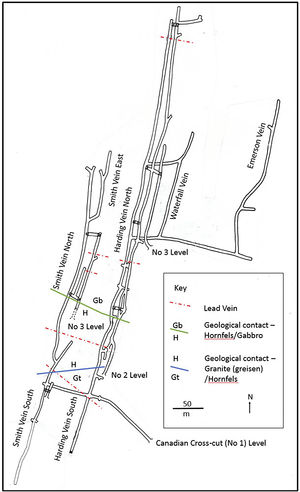
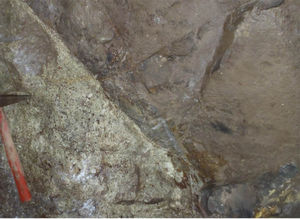
In the gabbro the veins are less well defined, largely consisting of zones, up to ca 3m wide, of extensive quartz veining (Figure 5, Figure 6 and Figure 7]) that includes individual quartz veins (up to 30 cm wide) in an en-echelon arrangement, as one structure fades an adjacent one expands. Varying quantities of quartz, calcite (Figure 9), wolframite (Figure 8) and scheelite (Figure 9) occur with minor fluorite, arsenopyrite, pyrite, pyrrhotite, sphalerite, apatite, dolomite, ankerite, galena, molybdenite, bismuth, bismuthite, columbite, cuprodamite, malachite, chalcopyrite, wurtzite, chrysocolla and gypsum. The gypsum is the product of the weathering of the sulphide minerals and the reaction of the resulting sulphuric acid with the carbonate minerals present in the veins. The distribution of stoping shows that ore grade tungsten mineralisation is variable with zones of higher grade, workable ore interspersed with barren stretches of the vein structures. The veins are complex structures of multiple, quartz dominated, veins with cross cutting relationships demonstrating multiple phases of mineralisation. The larger veins in these structures usually being a late or the last phase of the tungsten mineralisation. All these veins have visible scheelite and wolframite. Large vugs, mainly lined with quartz crystals, are frequent in the larger vein structures. The carbonate mineralisation in the tungsten vein structures appears to be a late phase of this episode of mineralisation and is much more abundant in and close to the gabbro than elsewhere in the mine workings, suggesting that the gabbro was a likely source of the calcium.
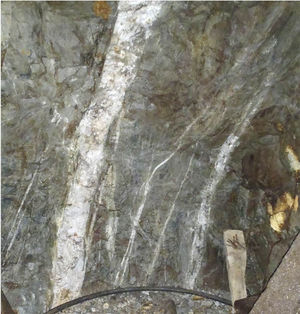
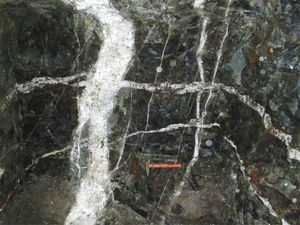
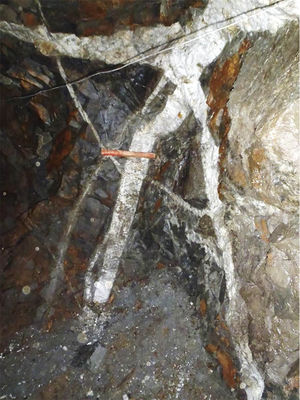

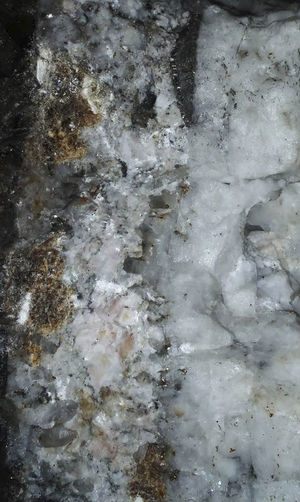
Lead Veins
The tungsten bearing veins are cut by a number of later so called lead veins (Figure 10, Figure 11, Figure 12, Figure 13 and Figure 14). They were referred to by the miners as lead veins because they are genetically related to the veins further north in the Caldbeck Fells that have been extensively worked for lead ores (Cooper and Stanley; 1990[6]). These trend approximately east-west and comprise multiphase crustiform banded mineralisation consisting of varying proportions of baryte and calcite with minor galena, sphalerite and other sulphides. The veins are near vertical, up to 1.5 m wide and can be traced between tungsten veins and between levels in the mine. The amount of lead in these veins was clearly not considered worth working and the veins have not been exploited anywhere in the mine workings. The veins show evidence of multiple phases of mineralisation and several phases of brecciation. The breccia show in Figure 12 is suggestive of collapse of broken wall rock into a fracture cavity prior to or at an early stage of mineralisation.
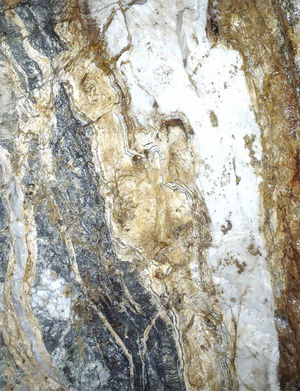
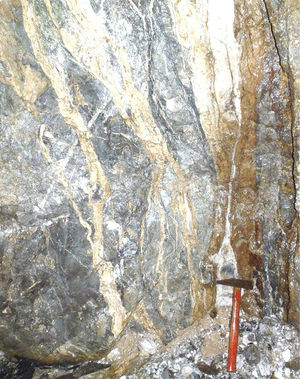
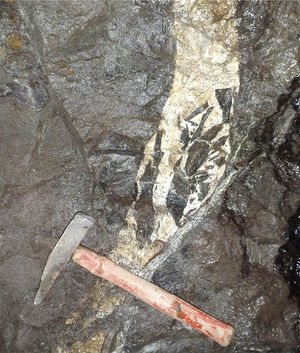
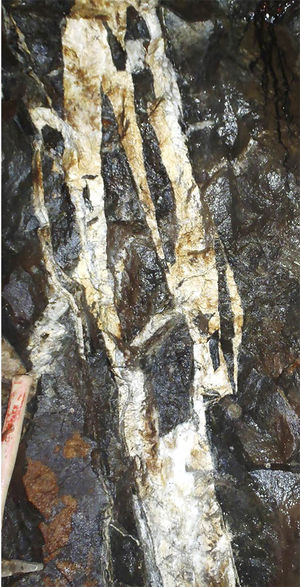

References
- ↑ COOPER, A H, FORTEY, NJ, HUGHES, R A, MOLYNEUX, S G, MOORE, R M, RUSHTON, A W A and STONE, P. 2004. The Skiddaw Group of the English Lake District: memoir for parts of sheets 22 Maryport, 23 Cockermouth, 24 Penrith, 28 Whitehaven, 29 Keswick, 30 Appleby, 31 Brough and 48 Ulverston; Memoir of the British Geological Survey; 147p.
- ↑ SHEPHERD, T J, BECKINSALE, R D, RUNDLE, C C, DURHAM, J J. 1976. Genesis of Carrock Fell tungsten deposit, Cumbria: fluid inclusion and isotopic study, Transactions of the Institution of Mining and Metallurgy Section B: Applied Earth Sciences 85(1) 1976 p.B63–B73.
- ↑ BALL, T K, FORTEY, N J, and SHEPHERD, T J. 1985. Mineralisation at the Carrock Fell Tungsten Mine, N England: Paragenetic, fluid inclusion and geochemical study; Mineralium Deposita 20, pp 57–65.
- ↑ 4.0 4.1 MOORE, J McM. 1977. Carrock Fell Tungsten Mine, Cumbria; Royal School of Mines Journal 1977; pp 7–14.
- ↑ MOORE, J McM. 1977. Carrock Fell Tungsten Mine, Cumbria; Royal School of Mines Journal 1977; pp 7–14.
- ↑ COOPER, M P and STANLEY, C J. 1990. Minerals of the English Lake District. Caldbeck Fells; London: Natural History Museum; 160p.